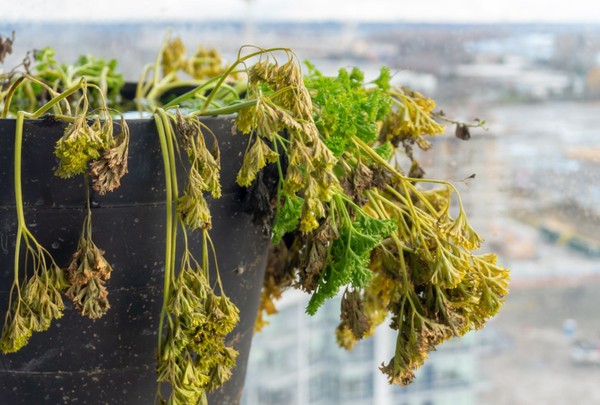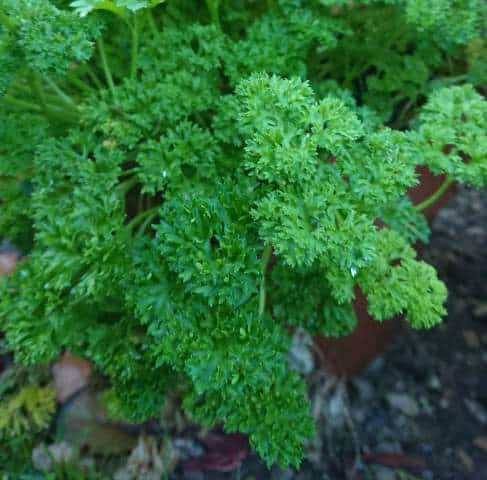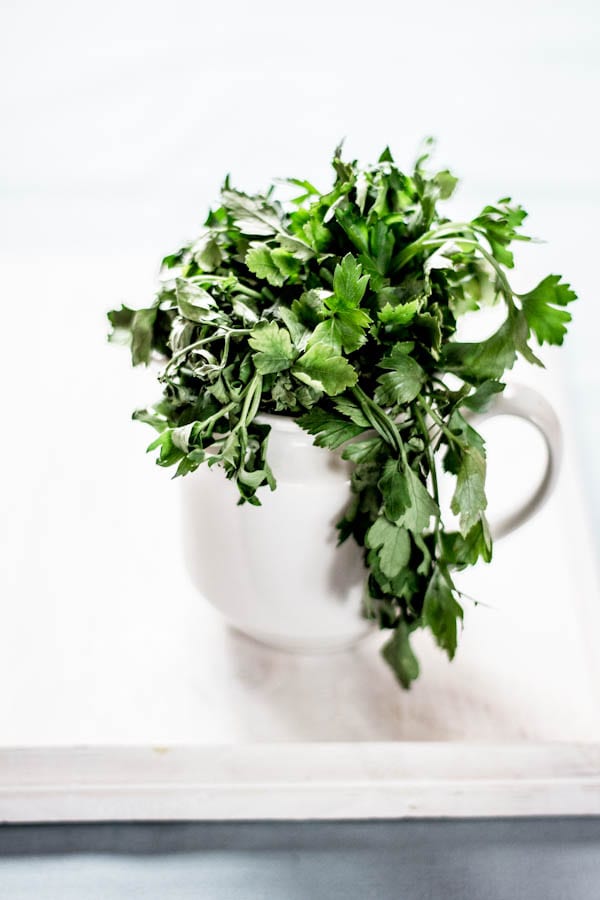
Parsley can wilt as a sign of stress due to a sudden contrast in conditions when grown indoors and then planted outdoors. Drooping parsley can also be a response to intense heat, drought, saturated soil, a lack of regular pruning, too much fertilizer, or parsley can wilt as a reaction to any of these factors.
Parsley is one of the first plants in a herb garden to wilt from dehydration and needs damp, well-draining soil to thrive effectively.
However, if you purchased your parsley as a young plant from a garden center or started it from seed indoors, it may briefly droop as it gets used to the changing temperature and soil conditions.
Depending on the cause, drooping parsley is frequently quickly revived.
Read on to see what led to your parsley wilting and what you can do to salvage it.
Table of Contents
Save Parsley Wilting or Drooping in Pots
The following are the causes of potted parsley drooping:
- The parsley wilts because the pot is too small and dries out too rapidly.
- Due to water stress and root rot brought on by a pot’s lack of drainage holes, parsley might droop.
Make sure you put parsley in a pot or container with a diameter of at least 12 inches if you don’t want it to wilt.
The roots of the parsley droop if the pot or container is too tiny since there is less room for soil and, consequently, less room for moisture.
Additionally, smaller pots and containers heat up in the sun much more quickly than larger ones, which accelerates soil evaporation and causes the parsley to droop as a symptom of stress.
How to fix it
Transplant your potted parsley to a larger pot with loads of compost to help it retain moisture if it continues to wilt despite regular watering.
After a few days, the parsley should reviv e with frequent watering and some protection from the severe heat of the sun.
While parsley can wilt (and become yellow) as an indication of stress from water-logged roots, it can also droop as a result of a lack of water.
Planting parsley in a pot without adequate drainage holes in the base, or setting the pot on a saucer or tray that prevents extra water from evaporating, is a common gardening error.
After watering your parsley, if the extra water cannot drain away from the container, the soil will quickly get saturated, which can foster the growth of root rot and other fungi diseases, leading your parsley to droop.
(For additional information, see my post on how to preserve yellowed parsley.)
As soon as possible, transplant your parsley into a pot or container with drainage holes. After the soil has had a chance to partially dry up, water it once more.
If the parsley has water sensitivity, it can recover from its wilted state in a few days. However, if the plant has serious root rot or a fungal illness and all of its leaves have turned yellow, I would advise getting rid of it because these conditions can make it difficult to salvage the plant.
Parsley Wilting on Hot Days (Despite Being Well Watered)
Even though your parsley is receiving plenty of water and is in ideal growing conditions, it can be annoying if it consistently droops in the summer.
In order to conserve water and limit transpiration from the leaves on hot Summer days, parsley briefly droops.
If you shield the parsley from direct sunlight or as the temperature drops, it will typically perk back up.
Although this brief drooping brought on by the heat is not harmful to the plant per se, if it happens every day as a result of extreme heat and light, I advise shielding it from the midday sun by relocating the pot to a shaded area for a few hours.
Parsley may thrive in either full or partial sunlight.
To aid in the recovery of your parsley from a drooping appearance, make sure the soil around it is wet (but not soaked).
Regular Pruning Prevents Parsley Drooping

Regular pruning is necessary to prevent parsley from becoming lanky and drooping.
In order to keep your parsley in a neat, even shape and keep it from sagging under its own weight over the spring and summer, you might need to prune it as regularly as once every three weeks.
In order to have a plentiful supply of parsley for cooking throughout the Spring and Summer, pruning parsley encourages more growth and a bushier plant.
It is advisable to clip parsley once it has grown taller than 8 inches to prevent drooping.
For an effective visual approach to pruning parsley, view this YouTube video:
Excess Fertilizer Causes Parsley to Droop
High nitrogen fertilizers or the use of soil additions like chicken manure are frequent causes of drooping parsley plants (which is particularly high in nitrogen).
The nitrogen in fertilizer encourages abundant foliage growth, which can make your parsley’s stems soft and sappy. This makes it more susceptible to drooping and pest bug attacks like aphids.
If you plant parsley in good compost, it doesn’t always need fertilizer to thrive, but if you want to maximize the crop, a half-strength all-purpose fertilizer can help to encourage more growth.
Always adhere to the manufacturer’s instructions when applying fertilizer to ensure that you don’t use too much and cause your parsley to droop.
The flavor and scent of parsley can be altered by too much nitrogen, therefore I advise cutting back any overly drooping growth. Under ideal conditions, the parsley should regrow in two to three weeks.
Parsley Drooping After Planting (Transplant Shock)
Because of the disparity between the conditions in which it was grown and the ones to which it has been transplanted, such as light, soil, frequency of watering, and temperature, transplant shock might cause your parsley plant to droop as a symptom of stress.
The roots must also adapt to the new soil’s structure, nutrient profile, and drainage requirements.
Parsley is more susceptible to dehydration after transplanting since the roots have not yet taken hold and the thick leaves can lose a lot of water (via transpiration) on hot, sunny days, which makes the parsley droop.
Therefore, you should endeavor to lessen transplant shock if you are moving a parsley plant you bought at the store or possibly one you started from seed outside.
It’s crucial to do the following in order to lessen transplant shock and, as a result, reduce how much your parsley droops or wilts:
- To keep the soil continuously moist so that the roots can draw up water more quickly than they lose it through their leaves, water the parsley every two to three days.
- Compost and leaf mold make an excellent potting mix for parsley because of their extraordinary ability to retain moisture and their high nutrient content.
- Avoid direct midday sunlight on parsley since it can enhance soil evaporation and leaf transpiration.
If you are growing parsley in the proper conditions, it should adapt to its new environment and regain its normal shape in about a week.
Drought Causes Parsley to Droop

Parsley is a native of the countries of the central and eastern Mediterranean, but due to the abundance of its leaves and their huge surface area, which causes more transpiration, it is far less drought resistant than many other Mediterranean herbs like lavender, rosemary, thyme, sage, and oregano (water loss from the leaves).
Water your parsley as often as necessary to keep the soil moist to avoid it from drooping due to drought.
Potted parsley should be watered once every two to three days throughout the height of summer, and possibly daily in really hot weather.
When the weather has been partly cloudy or there has been a lot of rain, watering once a week is typically sufficient to keep parsley from wilting or drooping.
Key Takeaways:
- Drought, a lack of routine trimming, or parsley may temporarily droop to help retain moisture on very hot days are the most frequent causes of drooping parsley.
- Due to poor drainage or small pots that dry out too soon in the sun, which causes drought, potted parsley frequently droops.
- The parsley grows swiftly in high nitrogen fertilizers but has weaker stems that can droop under their own weight.
- Parsley may droop when moved from the interior to the outside.
- Once parsley is taller than 8 inches, it should be clipped to encourage additional development and prevent the plant from drooping.
